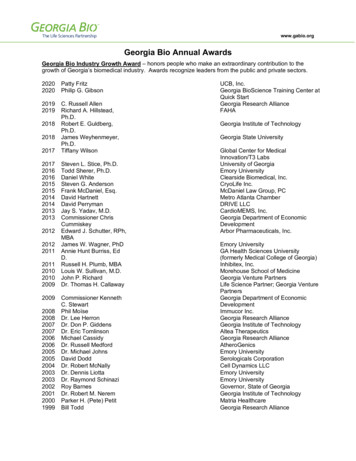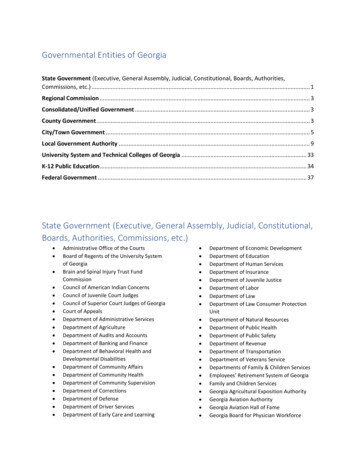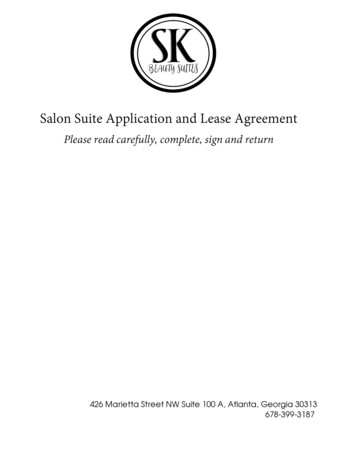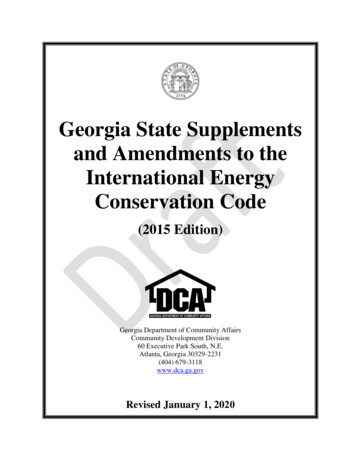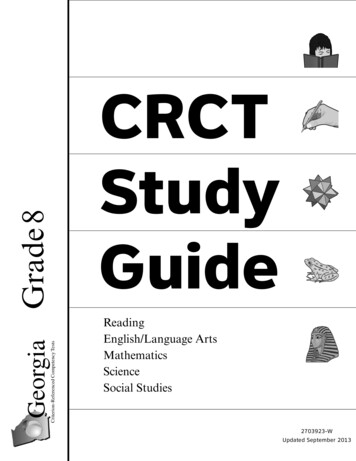
Transcription
Criterion-Referenced Competency TestsGeorgiaGrade 8CRCTStudyGuideReadingEnglish/Language ArtsMathematicsScienceSocial Studies2703923-WUpdated September 2013
Copyright 2013 by Georgia Department of Education.All rights reserved.
Table of ContentsUsing the CRCT Study Guide1About the CRCTOverview of the CRCTWhat is the CRCT?What does the CRCT measure?How are CRCT questions scored?2Preparing for the CRCTTest-Taking StrategiesRelated Links4Chapter 1ReadingReading Skills and Vocabulary AcquisitionLiterary ComprehensionInformation and Media LiteracyPractice QuizSolutions10Chapter 2English/Language ArtsGrammar/Sentence ConstructionResearch/Writing ProcessPractice QuizSolutions24Chapter 3MathematicsNumber and OperationsGeometryAlgebraData Analysis and ProbabilityPractice QuizSolutions42Copyright 2013 by Georgia Department of Education.All rights reserved.
Chapter 4ScienceStructure of MatterForce and MotionEnergy and Its TransformationsPractice QuizSolutions68Chapter 5Social ractice QuizSolutions82Copyright 2013 by Georgia Department of Education.All rights reserved.
Using the CRCT Study GuideThis Study Guide focuses on the knowledge and skills that are tested on theGeorgia Criterion-Referenced Competency Tests (CRCT). It is designed forteachers to use with their students and for parents to use with their children.Go to www.gadoe.org/ to find further information about and support forthe CRCT.The following section of this guide, “About the CRCT,” contains an overview ofthe CRCT and test-taking strategies to review with your students.–The content tested on the CRCT is based on Georgia’s state-mandatedcontent standards, which describe what all students should know,understand, and be able to do.The chapters of this guide are organized by subject. In each chapter you canexplore the skills needed to succeed in a specific tested domain (grouping ofsimilar content standards). The subject chapters include a snapshot of eachdomain, instructional Activities that address covered skills, and a PracticeQuiz with annotated Solutions to help assess student progress.This document is intended as a student resource. Photocopying is allowed asneeded for student use.Copyright 2013 by Georgia Department of Education.All rights reserved.Page 1 of 101
About the CRCTOverview of the CRCTWhat is the CRCT?The Grade 8 CRCT is a state-mandated achievement test that measures thesubject areas of Reading, English/Language Arts, Mathematics, Science, andSocial Studies.What does the CRCT measure?The CRCT is designed to measure student acquisition and understanding ofthe knowledge, concepts, and skills set forth in the state-mandated contentstandards.The tests accomplish the following:–––Ensure that students are learningProvide data to teachers, schools, and schooldistricts so they can make better instructional decisionsProvide data for use in Georgia’s accountability measures and reports.CRCT results measure the academic achievement of students, classes,schools, school systems, and the state. This information can be used toidentify individual student strengths and weaknesses or, more generally,to measure the quality of education throughout Georgia.How are CRCT questions scored?The CRCT currently uses only selected-response (multiple-choice) questions.There are four choices for each question, labeled A, B, C, and D.Students are not compared to each other. They are measured on theirachievement in meeting the standards. Scores are reported accordingto three performance levels: Does Not Meet the Standard, Meets theStandard, and Exceeds the Standard. For more information, go to the CRCTwebsite t/Assessment/Pages/CRCT.aspx.Copyright 2013 by Georgia Department of Education.All rights reserved.Page 2 of 101
About the CRCTOverview of the CRCTSince the spring of 2006, performance on the Reading portion of the CRCThas been linked to the Lexile Framework for Reading. Visit t/Assessment/Pages/LexileFramework.aspx for more information on this national reading measure.Copyright 2013 by Georgia Department of Education.All rights reserved.Page 3 of 101
About the CRCTPreparing for the CRCTTest-Taking StrategiesWeeksBeforethe TestSet academic goals with students for the upcoming weeksand months (short and long term). Write down and poststudents’ goals where they can be seen at least once a day.Help students gather study materials ahead of time.Set up a place to work that is free of distractions.Build in time to review what was learned in the last study session.Divide assignments into manageable chunks. Studying for a longtime non-stop is not productive!Model and have students mark the main idea of each paragraphwith a pencil as they read. This will help them focus on whatthey are reading.Have students ask questions that arise while they are studyingand encourage them to find the answers.At the end of each study session, review what they have learned.Copyright 2013 by Georgia Department of Education.All rights reserved.Page 4 of 101
About the CRCTPreparing for the CRCTDay Beforethe TestRemind students to get a good night’s rest.Remind students that they can talk to a teacher or parentif they are feeling nervous about the test.Assure students that this test is only one measureof their knowledge.Duringthe TestRemind students of the following strategies to use during the test:Relax by taking slow, deep breaths.Read the directions carefully. Make sure you understandwhat you need to do. If you are not sure, ask the teacher.Read each question carefully.When you use scratch paper, make sure that you copythe problem correctly from the test onto your paper.You can underline and make marks on your test to helpyou while you work, but the only answers that will be scoredare those in the correct locations on your answer sheet.Fill in the corresponding circle fully when you chooseyour answer. Erase any marks outside of the circle.Use your time wisely. Leave a question blank if youare unsure of the answer, then return to it at the end.Don’t spend too much time on one question.Be sure to answer all of the questions.Review your answers when you have finished the test.Try to stay calm during the test. This is a chance for youto show what you know. Do the best you can!Copyright 2013 by Georgia Department of Education.All rights reserved.Page 5 of 101
About the CRCTPreparing for the CRCTRelated LinksBelow are links to important resources that contain information relatedto the CRCT.CCGPS/GPS Resources:www.georgiastandards.orgCRCT Content and-Assessment/Assessment/Pages/CRCT.aspxCCGPS/GPS Frameworks:www.georgiastandards.orgLexile Framework for pyright 2013 by Georgia Department of Education.All rights reserved.Page 6 of 101
The Study Guides are intended to serve as aresource for parents and students. They containa few activities and short practice quizzes foreach content area. They also provide teachersan additional tool for student practice. Thestandards identified in the Study Guides addressa sampling of the state-mandated content standards.For the purposes of day-to-day classroominstruction, teachers should consult the widearray of resources that can be found atwww.georgiastandards.org.Since different students have different strengthsand needs, the activities in this Study Guidecan be scaffolded for students who need moresupport, extended to challenge advancedstudents, or presented as is (with appropriatemodeling) for grade-level students.Copyright 2013 by Georgia Department of Education.All rights reserved.Page 7 of 101
Copyright 2013 by Georgia Department of Education.All rights reserved.
ReadingCopyright 2013 by Georgia Department of Education.All rights reserved.
Chapter 1ReadingBy Grade 8, students have developed the analytical reading skills to read,understand, and analyze both literary and informational texts. Additionally, thesestudents successfully read and understand many different types of texts acrosssubjects. Students should be able to determine what unfamiliar words meanbased on how they are used. Students should also grasp how authors uselanguage differently depending on their purpose and the literary genre.The Reading activities focus on some of the concepts that are assessed onthe Grade 8 CRCT Reading domains. These domains are as follows:n Reading Skills and Vocabulary Acquisitiono Literary Comprehensionp Information and Media LiteracyCopyright 2013 by Georgia Department of Education.All rights reserved.Page 10 of 101
Chapter OneReadingActivitiesn Reading Skills and Vocabulary AcquisitionCommon Core Georgia Performance Standards ELACC8.L.4 and ELACC8.L.5By Grade 8, students have developed sophisticated vocabularies as well as theskills to determine the meaning of unfamiliar and multiple-meaning wordsusing context clues and common Greek and Latin roots and affixes. Studentsalso need to use reference materials to clarify or determine the precise meaningof unfamiliar and multiple-meaning words. In addition to figuring out wordmeanings, students should use these words within different contexts (e.g.,subject areas). Additionally, they should demonstrate understanding of figurativelanguage (e.g., figures of speech), word relationships, and nuances in wordmeanings (connotations).The following activities develop skills in this domain:–To help students develop vocabulary skills, students should play the Synonymand Word-Part Match game. For this activity, create pairs of synonyms and alist of word-parts with matching definitions. (Synonyms, word-parts, andword-part definitions are available online and in many grammar books.) Then,write each synonym or definition on a card, and give each student one card.At the beginning of the game, tell students to find their matching cards. Forsome groups, students should take turns reading their cards aloud. For othergroups (or as a variation on the original game), students should find theirmatches without speaking. Sample word pairs include the following: hesitantand indecisive; ponder and contemplate; courageous and valiant; auto- andself; re- and again; intra- and within; noun and person, place, thing, or idea.–To develop vocabulary skills, students should have Literary Word Banks.In these “banks,” students “deposit” unfamiliar words as they are reading inthe first of three columns. In the second column, each student guesses whatthe word means based on its context. In the third column, the student writes downthe dictionary definition he or she has looked up. On another page of the “bank,”students write down sentences using their new words. Students could also drawillustrations of these new vocabulary words and display them for others.–To promote students’ engagement with new vocabulary words, studentsshould do personalized vocabulary assignments with these words. Studentsmay use their friends’ names as part of the exercises. Demonstrating that theyunderstand the meanings of the vocabulary words, students must respond topersonalized questions or statements such as, Issue a decree to Sasha orDescribe Chris being churlish to Elizabeth or Describe a time you werescapegoated by your brother.Copyright 2013 by Georgia Department of Education.All rights reserved.Page 11 of 101
Chapter OneReading–To help students distinguish among the connotation of words with similardenotations, students should play the Loaded Words game. For this activity,students read each list of words below. Each word has a different connotation,but has the same general denotation. Students then decide what the generaldenotation is for each group. They write their answer on the line provided.They then number the words in each group from most positive connotationto most negative connotation.Example:3. thin4. bony1. slim2. slenderGeneral denotation:Light in ngindecisiveuncertainGeneral ingGeneral yunplannedGeneral denotation:Copyright 2013 by Georgia Department of Education.All rights reserved.Page 12 of ntsublimeGeneral msaddlestrainGeneral denotation:
Chapter OneReadingActivitieso Literary ComprehensionCommon Core Georgia Performance Standards ELACC8.RL.1, ELACC8.RL.2,ELACC8.RL.3, ELACC8.RL.4, ELACC8.RL.5, ELACC8.RL.6, and ELACC8.RL.9Grade 8 students read and understand many different types of literary texts.How an author crafts a literary text is as significant as what the text literallystates. Students must determine themes, provide summaries, and analyzehow story elements interact, using explicit textual evidence to support theiranalyses. Students must also analyze the impact of the author’s language andstructure on the meaning of a literary text, as well as how the author developsthe points of view of different characters in relationship to the reader to createsuch effects as dramatic irony. Finally, students should compare and contrastmodern literary texts to traditional stories to develop an understanding of howmodern fiction draws on similar themes, patterns of events, or character types.The following activities develop skills in this domain:–To help students understand the concept that dialogue and events helpto reveal aspects of a character and provoke decisions, students shouldexamine characters’ reactions after significant events in a story. Studentsshould imagine they are newspaper reporters assigned to interview theparticipating characters and script several interviews with the characters.The interviewer should elicit responses from the characters that revealboth a deep understanding of the characters’ traits and motivations andalso an awareness of the plot events that have occurred. The interviewer’squestions should reveal certain conclusions he or she has made about thecharacters being interviewed. Students should write their mock interviewsin the style of a play.–To supplement students’ reading of poetry and to help them understandmetaphor as a literary device, students should examine several metaphorssuch as my love is a rose and her hair is golden silk. Students should explainwhy the speaker would call his love a flower and describe hair as golden silk.Students should discuss what qualities the speaker’s love has that wouldwarrant these comparisons. Students should practice writing with their ownmetaphors. After reading a poem, such as Langston Hughes’s “Mother to Son,”in which the speaker compares his life to a staircase, students should choosesomething to which they can compare their lives. They then should make listsof the shared aspects of both. For example, for the statement my life is aroller coaster students could write the following: both have ups and downs,both can be scary, both have slow times and fast times. Students should takethese statements and create short poems. To enhance students’ appreciationof the visual power of metaphors, students should illustrate their metaphors.Copyright 2013 by Georgia Department of Education.All rights reserved.Page 13 of 101
Chapter OneReading–To help enhance students’ knowledge of sensory details and the impact ofspecific word choice on meaning and tone, students should close their eyesand listen to a descriptive, sensory-rich excerpt of literature. After the passagehas been read aloud, students should identify the tone of the passage and theelements that contributed to it. To encourage students to pay attention tosensory details, students should taste differently flavored hard candies anddescribe them together. They should smell a series of spices and describewhat they are reminded of. Then, they should feel and describe severalobjects of varying textures. Next, students should write their own sensorydetailed pieces in which they describe objects using all five senses.–To help students understand dramatic irony, have students view televisionprograms/movies on their own and write about the dramatic irony theyfind. How does the audience have more knowledge than the characters?Finally, have students rewrite the story with all of the characters knowingwhat the audience knows. How is the story different?Copyright 2013 by Georgia Department of Education.All rights reserved.Page 14 of 101
Chapter OneReadingActivitiesp Information and Media LiteracyCommon Core Georgia Performance Standards ELACC8.RI.1, ELACC8.RI.2,ELACC8.RI.3, ELACC8.RI.4, ELACC8.RI.5, ELACC8.RI.6, ELACC8.RI.7, ELACC8.RI.8,and ELACC8.RI.9As students encounter various types of media as well as workplace and consumermaterials, they need strong skills to analyze the development of central ideas,the ways in which a text makes connections between individuals, events, andideas, as well as the figurative, connotative, and technical meanings of wordsand phrases. Students must also analyze the structure authors use to organizea text, how authors distinguish their point of view from that of others, wheredifferent authors disagree in matters of fact or opinion, and if authors supporttheir arguments and claims with sound reasoning and evidence. Because a greatdeal of informational texts are in a multi-media format, students must also beable to compare and contrast different media versions of text and determine howeach format impacts the portrayal of the subject and whether it was an advantageor disadvantage to use a particular format for a subject.The following activities develop skills in this domain:–To help students examine a piece of text that has a strong point of view andunderstand how the author structures his or her argument, students shouldanalyze and organize sentences in a persuasive paragraph. Magazine articlescan be effective and readily available sources for such paragraphs. For thisactivity, a persuasive paragraph is divided into sentences, each written on ablank index card. Several sentences that are not relevant and do not supportthe thesis of the paragraph should be included as distracters. Students shouldarrange the index cards to create a cogent and logical argument. First, studentsmust determine the author’s position. Next, they should choose the sentencesthat support the author’s argument and put them in an effective sequence.Students must also recognize and remove the distracter sentences, makingsure they can explain why the sentences do not belong. Finally, studentsshould present their paragraph arrangements and describe the developmentof the author’s perspective and argument.–To enhance students’ inferential skills and to enhance their ability to integrateinformation from multiple texts, students should compare and contrastdifferent arguments on the same topic from several sources. Students shouldexamine two different sources and analyze the ways in which these sourcesaddress the same topic(s). First, students should brainstorm a list of thearguments or claims in each of the sources. Next, they should examine theirlists and see the common thread(s) among them. Then, students shouldlist the ways in which the topic is addressed similarly and the ways it isaddressed differently in these sources. Finally, students should write essayscomparing and contrasting the different arguments. The paper should includewhich argument they felt was the most valid and persuasive.Copyright 2013 by Georgia Department of Education.All rights reserved.Page 15 of 101
Chapter OneReading–To help students evaluate the advantages and disadvantages of usingdifferent mediums, present the students with a list of different topics.Ask them to decide what type of medium would be best to address thetopic. Once they have presented their observations, present severaldifferent types of mediums that address the topic. How did the students’initial observations compare to the actual presentation? Was one type ofpresentation better than another?Copyright 2013 by Georgia Department of Education.All rights reserved.Page 16 of 101
Chapter OneReadingPracticeQuizGenre: Literary TextRead the passage below and answer the questions that follow.MemoriesMy cat sits comfortablyOn our windowsill.Her tail flicksHer whiskers flare.A primitive grumble rises out of her throat.Outside a chipmunk nibbles innocently,Seemingly unaware of the threatening cat.He sits straight upHis ears rotate.In the blink of an eye he is gone.I sit back in my chairAnd giggle to myself.For even if my brave hunter could get out,The domestic cat now lacksThe tools to fulfill the old desires.1How does the author of the poem build suspense in the first twostanzas?A by making it clear that the chipmunk knew the cat was watchingB by providing the perspective of both the cat and the chipmunkC by limiting the amount of information provided to the readerD by sharing with the reader the perspective of the speaker2Which of these BEST reflects a theme in the poem?A Wisdom comes with age.B Appearances can be deceiving.C Joy can be found in small events.D Observation can be a good teacher.Copyright 2013 by Georgia Department of Education.All rights reserved.Page 17 of 101
Chapter OneReading3Which of these can be concluded about the cat based on the lasttwo lines?The domestic cat now lacksThe tools to fulfill the old desires.ABCDSheSheSheShecannot get outside.is not an indoor pet.does not want to be a hunter.does not have the skills to hunt.4Why does the speaker MOST LIKELY refer to the cat asmy brave hunter?A The speaker is using a pun to show how silly the cat is.B The speaker is using irony to create humor about the real natureof the cat.C The speaker is using a comparison to demonstrate how fierce thecat is.D The speaker is using personification to illustrate how much suspensethe cat is experiencing.5Which event creates the MOST change in the cat?A Outside a chipmunk nibbles innocently,B In the blink of an eye he is gone.C I sit back in my chairD And giggle to myself.6Which of these details BEST develops the theme of the poem?A A primitive grumble rises out of her throat.B Seemingly unaware of the threatening cat.C In the blink of an eye he is gone.D The tools to fulfill the old desires.7What does this line from the poem reveal about the chipmunk?In the blink of an eye he is gone.ABCDHeHeHeHewas not aware of any danger.closed his eyes suddenly.was never really there.ran away quickly.Copyright 2013 by Georgia Department of Education.All rights reserved.Page 18 of 101
Chapter OneReading8Which phrase BEST expresses the meaning of her whiskers flare as it isused in the first stanza?A The cat is excited about what she sees.B The cat’s whiskers have a unique ability.C The cat’s whiskers start to shine in the light.D The cat is amused that there is an animal in the yard.Use the information in the box below to answer the question.primitive adj. 1. lacking refinement 2. without official training3. related to an ancient time 4. at an early stage of development9What does primitive mean in this line from the poem?A primitive grumble rises out of her n123410 The word rotate is derived from the Latin root rota, which means“wheel.” Based on the root, what is the BEST meaning of rotate?A to turnB to buildC to travelD to shapeCopyright 2013 by Georgia Department of Education.All rights reserved.Page 19 of 101
Chapter nAnalyze how differences in the points of views of thecharacters and the reader create such effects as suspenseor humor. (ELACC8.RL.6)The correct answer is Choice (B) by providing theperspective of both the cat and the chipmunk. Thereis more suspense because the reader sees the samesituation through both characters. Choice (A) is incorrectbecause the chipmunk is originally presented as being“seemingly unaware” of the cat. Choice (C) is incorrectbecause the reader is in fact provided more informationthrough the different character perspectives. Choice (D) isincorrect because the speaker’s portion of the poem doesnot create suspense but rather removes it.2BDetermine a theme of a text. (ELACC8.RL.2)The correct answer is Choice (B) Appearances can bedeceiving. The cat represents danger in the poem, but itis revealed that despite the outward appearance she reallyis not a threat to the chipmunk. Choice (A) is incorrectbecause even though the past is mentioned in the poem,it does not reflect a theme in the poem. Choice (C) isincorrect because even though the speaker giggles it doesnot reflect a theme in the poem. Choice (D) is incorrectbecause even though the speaker observes the events itdoes not reflect the theme of the poem.3DCite the textual evidence that most strongly supportsan analysis of what the text says explicitly as well asinferences drawn from the text. (ELACC8.RL.1)The correct answer is Choice (D) She does not havethe skills to hunt. This inference can be drawn basedon the fact that she now “lacks the tools to fulfill theold desires.” Choices (A), (B), and (C) are based on amisunderstanding of the information presented inthe lines.Copyright 2013 by Georgia Department of Education.All rights reserved.Page 20 of 101
Chapter t figures of speech in context. (ELACC8.L.5a)The correct answer is Choice (B) The speaker is usingirony to create humor about the real nature of the cat.The speaker really is meaning the opposite of what shesays in the poem. Choices (A), (C), and (D) are incorrectbecause the speaker is not using a pun, comparison, orpersonification.5AAnalyze how incidents propel the action. (ELACC8.RL.3)The correct answer is Choice (A) Outside a chipmunknibbles innocently. It is this event in the poem thatpropels the cat to have a reaction and reveal her nature.Choice (B) is incorrect because it occurs after the cat hasreacted. Choices (C) and (D) are incorrect because theyare related to the speaker’s reaction and not the cat’sreaction.6DAnalyze the development of theme over the course ofthe text. (ELACC8.RL.2)The correct answer is Choice (D) The tools to fulfill theold desires. This line establishes that looks can bedeceiving. Choice (A) is incorrect because it only establishesthat the cat appears to be threatening. Choices (B)and (C) are incorrect because they help develop thecharacter of the chipmunk and not the theme of the poem.7DDetermine the meaning of figurative language.(ELACC8.RL.4)The correct answer is Choice (D) He ran away quickly.The line uses figurative language to express the speed inwhich the chipmunk disappeared. Choice (A) is incorrectbecause even though the chipmunk was not in danger,this idea is not expressed in the figurative language.Choices (B) and (C) are incorrect because they representa literal interpretation of the figurative language.Copyright 2013 by Georgia Department of Education.All rights reserved.Page 21 of 101
Chapter e the meaning of words and phrases as usedin a text. (ELACC8.RL.4)The correct answer is Choice (A) The cat is excitedabout what she sees. The phrase is used to illustratethat the cat is excited. Choices (B) and (C) are incorrectbecause they are based on a misunderstanding of theword flare. Choice (D) is incorrect because it representsan unsupported inference based on the phrase.9CConsult general and specialized reference materials.(ELACC8.L.4c)The correct answer is Choice (C) definition 3. Based onthe context of the line this is the best definition. Choices(A), (B), and (D) all represent definitions that would notbe accurate in the context of the line.10AUse common, grade-appropriate Greek and Latin affixesand roots as clues to the meaning of a word. (ELACC8.L.4b)The correct answer is Choice (A) to turn. Based on theroot this would be the most appropriate definition.Choices (B), (C), and (D) are based on a misunderstandingof how the root helps to provide meaning to a word.Copyright 2013 by Georgia Department of Education.All rights reserved.Page 22 of 101
English/Language ArtsCopyright 2013 by Georgia Department of Education.All rights reserved.
Chapter 2English/Language ArtsBy the end of Grade 8, students have a strong understanding of standard rulesof grammar and punctuation, and correct spelling. Additionally, students knowand understand the appropriate use of voice and mood to achieve particulareffects in writing. Students should convey good command of different modesof writing, including argumentive, as well as an understanding of how eachmode is used. Students have increased their ability to use descriptive wordsand complex sentences. They continue to gain proficiency in critiquing theirown and others’ writing constructively, gaining practice with editing andproofreading. When researching, Grade 8 students use primary and secondarysources appropriately. Grade 8 students should be able to select effectiveorganizational structures for their writing and ensure coherence by usingtransitional words and phrases. They should bring closure to their compositionswith strong conclusions.The English/Language Arts activities focus on some of the concepts that areassessed on the Grade 8 CRCT English/Language Arts domains. These domainsare as follows:n Grammar/Sentence Constructiono Research/Writing ProcessCopyright 2013 by Georgia Department of Education.All rights reserved.Page 24 of 101
Chapter TwoEnglish/Language ArtsActivitiesn Grammar/Sentence ConstructionCommon Core Georgia Performance Standards ELACC8.L.1, ELACC8.L.2,and ELACC8.L.3Within the Grammar/Sentence Construction domain, students should be ableto understand and use verbals in
CRCT Study Guide Reading English/Language Arts Mathematics Science Georgia Criterion-Referenced Social Studies Competenc y Tests


